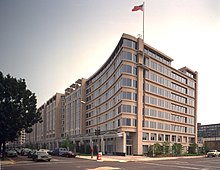NASA
NASA sī Kok-ka Hâng-khong kap Thài-khong Hêng-chèng Kio̍k (KHTH; National Aeronautics and Space Administration) ê Eng-gí kán-siá. In sī Bí-kok tī 1958-nî khí-ki ê 1-ê ki-kò·, choan-mn̂g hū-chek Bí-kok ê kok-ka ú-tiū hoat-tián kè-e̍k. Chit-ê ki-kò· mā hū-chek tn̂g-kî ê bîn-kan hām kun-sū ê ú-tiū poe-thiⁿ gián-kiù.
 NASA seal | |
 NASA "meatball" insignia | |
 NASA "worm" logotype | |
 NASA headquarters in Washington, D.C. | |
| Agency overview | |
|---|---|
| Abbreviation | NASA |
| Formed | 1958 nî 7 goe̍h 29 ji̍t |
| Preceding agency |
|
| Type |
Space agency Aeronautics research agency |
| Jurisdiction | United States Federal Government |
| Headquarters |
Washington, D.C. 38°52′59″N 77°0′59″W / 38.88306°N 77.01639°W |
| Motto | For the Benefit of All[2] |
| Bill Nelson | |
| Deputy Administrator | Pamela Melroy |
| Primary spaceports | |
| Owner |
|
| Employees | 17,373 (2020)[3] |
| Annual budget |
|
| Website | NASA.gov |
NASA ê lí-sióng sī "beh kái-siān chia ê seng-oa̍h, kā seng-oa̍h hùn-toā khì kàu hit-ūi, koh khì chhoē-tio̍h tī hn̄g-hn̄g hit-pêng ê oa̍h-miā." NASA ê sú-bēng sī "beh liáu-kái hām pó-hō· lán ê tē-kiû, chhím-khoàⁿ chit-ê ú-tiū, koh cháu-chhoē tē-kiû í-goā ê oa̍h-miā, hām kó·-lē āu-chi̍t-tāi ê chhím-khoàⁿ-chiá."
Tsù-kái
siu-kái- ↑ US Centennial of Flight Commission, NACA Archived February 20, 2014, at the Wayback Machine.. centennialofflight.net. Retrieved on November 3, 2011.
- ↑ Lale Tayla; Figen Bingul (2007). "NASA stands 'for the benefit of all.'—Interview with NASA's Dr. Süleyman Gokoglu". The Light Millennium. goân-loē-iông tī October 12, 2007 hőng khó͘-pih. September 17, 2018 khòaⁿ--ê.
- ↑ "Workforce Profile". NASA. goân-loē-iông tī April 27, 2020 hőng khó͘-pih. April 23, 2020 khòaⁿ--ê.
- ↑ "NASA's FY 2022 Budget". The Planetary Society. goân-loē-iông tī 28 May 2021 hőng khó͘-pih. June 28, 2022 khòaⁿ--ê.
Tsham-khó bûn-hèn
siu-kái- Catchpole, John E. (June 17, 2008). The International Space Station: Building for the Future. Springer-Praxis. ISBN 978-0-387-78144-0.
Ên-sin ua̍t-to̍k
siu-kái- Alexander, Joseph K. Science Advice to NASA: Conflict, Consensus, Partnership, Leadership (2019) excerpt
- Bizony, Piers et al. The NASA Archives. 60 Years in Space (2019)
- Brady, Kevin M. "NASA Launches Houston into Orbit How America's Space Program Contributed to Southeast Texas's Economic Growth, Scientific Development, and Modernization during the Late Twentieth Century." Journal of the West (2018) 57#4 pp 13–54.
- Bromberg, Joan Lisa. NASA and the Space Industry (Johns Hopkins UP, 1999).
- Clemons, Jack. Safely to Earth: The Men and Women Who Brought the Astronauts Home (2018) excerpt
- Dick, Steven J., and Roger D. Launius, eds. Critical Issues in the History of Spaceflight (NASA, 2006)
- Launius, Roger D. "Eisenhower, Sputnik, and the Creation of NASA." Prologue-Quarterly of the National Archives 28.2 (1996): 127–143.
- Pyle, Rod. Space 2.0: How Private Spaceflight, a Resurgent NASA, and International Partners are Creating a New Space Age (2019), overview of space exploration excerpt
- Spencer, Brett. "The Book and the Rocket: The Symbiotic Relationship between American Public Libraries and the Space Program, 1950–2015," Information & Culture 51, no. 4 (2016): 550–82.
- Weinzierl, Matthew. "Space, the final economic frontier." Journal of Economic Perspectives 32.2 (2018): 173–92. online Archived 2021-12-31 at the Wayback Machine., review of economics literature
Tsham-ua̍t
siu-kái- KAI T-50 kim-ing-sik khin-hîng kong-kik-ki (KAI T-50 Golden Eagle)
Guā-pōo lên-ket
siu-kái| Wikisource ū koan-hē pún bûn-chiong ê goân-sú bûn-pún: |
| Wikisource has original works written by or about: NASA |
- NASA official website
- NASA Engineering and Safety Center
- NASA History Division
- Monthly look at Exploration events Archived 2021-03-08 at the Wayback Machine.
- NODIS: NASA Online Directives Information System
- NTRS: NASA Technical Reports Server
- NASA History and the Challenge of Keeping the Contemporary Past Archived 2021-03-23 at the Wayback Machine.
- NASA podcasts
- NASA Watch, an agency watchdog site
- NASA tī Internet Archive ê chok-phín
- How NASA works on howstuffworks.com
- Quest: The History of Spaceflight Quarterly